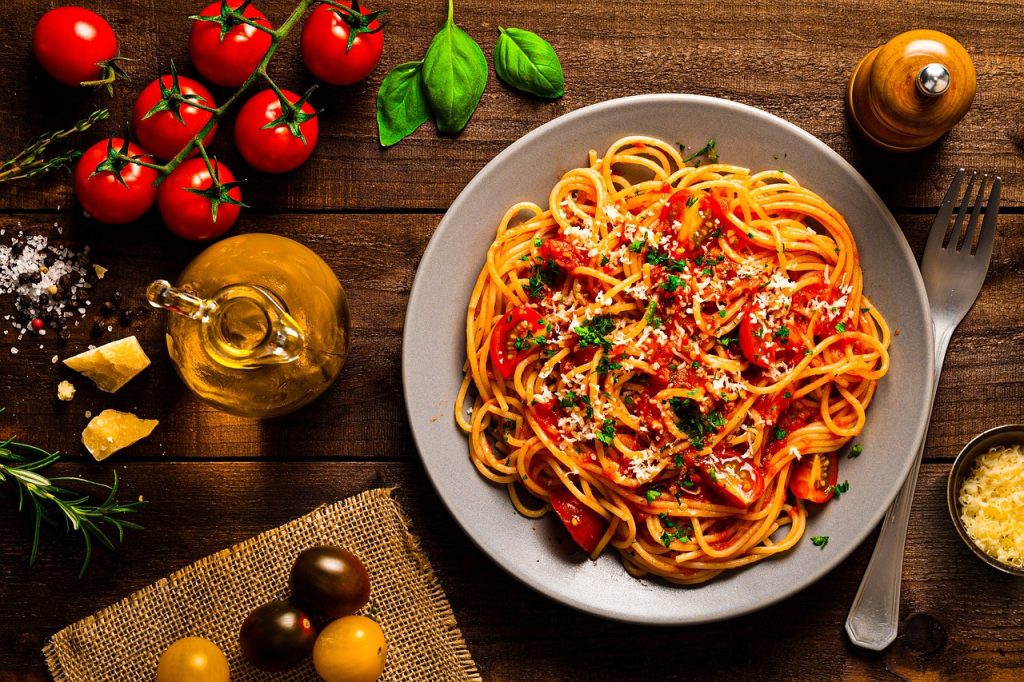
Gout patients are usually advised to reduce their consumption of high-purine foods. What about pasta? Read on to discover the health benefits of pasta, what happens when you consume too much, who should avoid it, and how it may affect your gout if you’re not careful.
Gout
Gout is a painful inflammatory form of arthritis caused by an accumulation of uric acid crystals in the joints due to abnormally high levels of uric acid in the blood, a condition called hyperuricemia.
Typical symptoms of a gout attack (aka gout flare) include: sudden intense pain, inflammation, swelling, redness, warmth, and stiffness.
Attacks occur most often in the joint at the base of the big toe, but other joints may be affected too, such as the elbows, wrists, knees, and fingers.
Uric acid is the end product of purine metabolism, which purines are natural chemical compounds found in the cells of all living things, including we humans, animals, marine life, and plants.
Gout is more common in men, particularly those who are middle aged or older, and those with a family history of gout, although women can be equally at risk after the menopause.
Other known risk factors include:
- being overweight/obese
- high alcohol consumption (especially beer)
- a high-purine diet (see below)
- fructose (especially high fructose corn syrup in processed foods and sugary drinks)
- some medical conditions (e.g., diabetes, hypertension, thyroid problems)
- some medications (e.g., diuretics, niacin, aspirin)
It’s reckoned that around 30% of the uric acid produced in our bodies comes from the food we eat: a not inconsiderable amount.
Which is why gout patients, in addition to their prescribed gout medications, are usually advised to change to a low-purine diet that completely avoids high-purine foods, such as wild game, organ meats, seafood, gravies, and yeast products.
Moderately-high purines foods, like lean red meat, poultry, and some species of seafood, have to be strictly limited.
Low-purine foods, such as vegetables, fruit, nuts, seeds, low-fat dairy products, eggs, and whole grains, are promoted.
Although there isn’t a cure for gout, with proper treatment and some lifestyle and dietary adjustments, it can be managed such that the risk of recurrent gout flare-ups is vastly reduced.
It’s important to note, here, that several studies associate gout with an increased risk of serious health conditions, such as kidney and liver disease, diabetes, stroke, heart disease, and even early death.
So the earlier a diagnosis is made and the appropriate treatment commenced, including recommended lifestyle and dietary changes, the less the risk of such complications.
Pasta
Pasta has been with us for centuries, with evidence of it having been eaten as early as the 4th century BC.
It’s also recognized as one of the staples of Italian cuisine, with its first reference dating back to 1154 in Sicily, although it’s very popular in many countries around the world today.
It’s usually made from durum wheat flour or semolina, mixed with water or eggs and kneaded until smooth, then rolled out, cut, and then shaped into long strings, tubes, shells, elbows, and butterflies/bowties, etc. The pasta’s then boiled in water to cook until tender but firm.
There are many different types of pasta available, such as spaghetti, penne, macaroni, ravioli, and more, which can be served with sauces, cheese, vegetables, meats, seafood, and other ingredients.
It can also be used in many different types of dishes, for example, in casseroles, soups, baked dishes, salads, and even served as a side dish or appetizer.
With so many types and flavors available, it’s easy to find a pasta dish that everyone in the family can enjoy. It’s a great choice for busy households, as it cooks quickly and can be combined with a variety of ingredients for a tasty meal.
Health Benefits of Pasta
Pasta is low in fat and an excellent source of fiber, vitamins, minerals, and antioxidants.
It shouldn’t be surprising, then, that a study, published in Frontiers in Nutrition in 2020, links pasta consumption to greater nutrient intakes and improved diet quality, compared to non-pasta consumption, in Americans.
Furthermore, several studies (example) associate a fiber-rich diet with a lower risk of heart disease, stroke, type 2 diabetes and bowel cancer.
And, interestingly, another study has confirmed that pasta is low to medium on the Glycemic Index (GI); the actual value depending on the type of pasta.
This means that a reasonable serving of pasta should not spike blood sugar after eating, unlike high-GI foods that are quickly digested and absorbed, resulting in a sharpe rise in blood sugar.
Pasta’s high-fiber content helps to slow down this process so that blood sugar rises more slowly and without reaching the heights of high-GI foods.
Whole-grain pasta has up to twice the fiber that processed pasta has, so is even more effective in controlling blood sugar.
So, when selecting a healthy pasta, choose whole-grain varieties that, not only have more fiber, but also retain more of their vitamins, minerals, and other beneficial nutrients.
However, if white pasta is still your preferred choice, then look for pasta that’s been enriched with added fiber, vitamins and minerals, as these can make up some of the gap.
And, it’s important to choose pasta that’s low in sodium, fat, and sugar, as these can all have a negative impact on health.
But whichever type of pasta you choose, be careful: there may be some risks with consuming too much…
Potential Problems with Pasta
There are some potential health risks associated with consuming too much pasta.
White pasta is very high in carbohydrates, whole-grain only slightly less so, so that even although they’re not high-GI foods, your blood sugar could increase markedly if you consume too much at one sitting: more so if you do this frequently.
Furthermore, studies link high-carb diets with weight gain, type 2 diabetes, metabolic syndrome, and other chronic diseases.
It’s therefore important to be prudent when consuming pasta: only consume it in moderation, since carbs can quickly add-up during the day, when you include your other foods.
On a different note, pasta made from wheat contains gluten, a protein found in wheat, barley, and rye.
People with celiac disease or non-celiac gluten sensitivity have to avoid foods with even the tiniest trace of these grains. However, gluten-free pastas are now available.
What about gout though? Could too much pasta increase uric acid levels?
Is Pasta Bad for Gout?
Pasta (whole-grain and white) is low in purines and fructose so, in these terms at least, is safe to eat in a healthy gout diet.
It’s also a low GI food, and studies have shown a positive association between the GI rating of a food and uric acid.
However, just because its a low-purine, low-fructose, low-GI food, doesn’t mean that you can eat large quantities of pasta without some potential gout consequences.
Remember, pasta is very high in carbs that can raise blood sugar faster, and higher, than normal when overconsumed. This, in turn, can increase blood uric acid levels and your risk of gout flares.
And bear in mind that, although it’s also a low-purine, low-fructose food, everything else you consume will have purines and fructose (at varying concentrations) and these add up across the day, as do those carbs.
So, notwithstanding the health consequences mentioned previously, your risk of recurring gout flare-ups also increases when pasta is consumed excessively.
The takeaway is that pasta, particularly whole-grain pasta, is generally considered safe for people with gout, when consumed in moderation.
But, keep in mind, the risk increases when consumed with high-purine foods, such as organ meats, fish, and shellfish: so these should be avoided.
Even moderate-purine foods, such as red meat and poultry, should be used sparingly with pasta.
Who Souldn’t Eat Pasta
People with celiac disease or non-gluten sensitivity should not eat pasta because it contains gluten, a protein found in wheat, barley, and rye.
Pasta can cause an immune reaction in people with those conditions, leading to uncomfortable, and sometimes dangerous, symptoms.
People with diabetes may eat pasta, but they should choose whole-grain types and watch their portion size as it’s still high in carbohydrates and can spike blood sugar when consumed to excess.
Additionally, those following a low-carb or ketogenic diet may choose to limit or avoid pasta because of its high carbohydrate content.
Summary
Overall, pasta can be a nutritious and delicious part of a balanced gout diet and is considered safe when consumed in moderation.
Whole grain pasta is generally healthier than white pasta, as it contains more fiber and is lower in calories. However, if whole-grain pasta isn’t your cup of tea — I don’t particularly like it myself — enriched white pasta is available nowadays.
People with celiac disease or gluten sensitivity should not eat pasta, and people with diabetes should watch their portion size to avoid a spike in blood sugar levels.
Eating too much pasta can have health consequences and increase the risk of recurring gout flare-ups. Therefore, it’s important to be prudent when consuming pasta, not forgeting what it’s served with.
Here’s my favorite pasta dish. Just remember portion size…
Spaghetti Aglio E Olio Recipe
===================================================================================
?????????????????????????????????????????????????????
This is backed up by studies showing that pasta has no significant effect on uric acid levels.Not only is more fiber better for your overall health, it may even help gout when not overconsumed.
U.S. Food and Drug Administration recommends at least half of your grain servings come from whole grains
But, not only is more fiber better for your overall health, studies have shown that fiber may even help gout by ing elevated uric acid levels and reducing inflammation.



